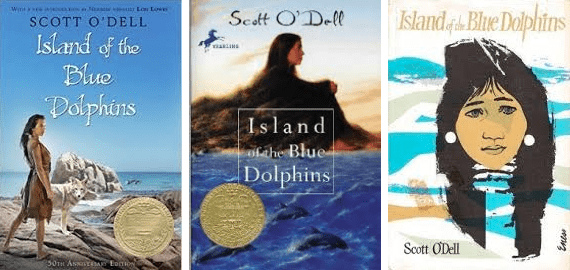
50th anniversary, 1995 edition, and first edition covers¬†of Island of the Blue Dolphins, by Scott O’Dell. Fair use rationale.
Island of the Blue Dolphins is a 1960s children’s book by Scott O’Dell, and it tells the story of a young girl who gets stranded for years on an island off the Californian coast. Juana Maria was a Native American who was left for 18 years on San Nicolas Island during the 19th century, before her eventual rescue by otter hunter George Nidever in 1853. O’Dell’s book dramatizes the experiences of the “Lone Woman of San Nicolas Island” whom he called Karana, and is a testament to her resourcefulness and perseverance.
As the story itself is not usually illustrated, we’ll look at three examples of the book’s cover illustration to consider representations of Karana. However, it’s important to first understand her story to consider how she is depicted. In the book, Karana is left on her native island with her brother when they miss the boat taking their village to the mainland. The two do their best to survive on the island until the ship comes back for them, however Karana soon loses her brother to a pack of feral dogs, and steps up to take the traditionally male tasks of hunting, weapon making and canoe building in order to survive, also constructing a shelter for herself made of whale bones as the real life Juana did. Without human company she befriends and tames some of the animals she encounters on the island — the favorite is a wild dog whom she names Rontu (meaning “Fox-eyes” in her language). As in the real story, she is eventually rescued, taken to the mission in Santa Barbara, and though she is made to alter her appearance to be “fit” for the mainland, she accepts it is part of her new life.
The first cover shows her standing on a rock looking out toward the ocean, a dog emerging from behind her legs. She is dressed in animal skins with bare feet and loose hair, in the mould of the somewhat idealized, traditional & old fashioned vision of a “savage” island girl, akin to images of Pocahontas we may have seen before. The second cover shows her as part of the land itself, rising up out of the hillside with her hair and clothes transforming into a grassy slope. Unlike the first cover there is no particular allusion in her dress to her being Native American, indeed she seems more like a nature goddess than a human in her body, merging with the landscape. Again she is looking out at the ocean, though she is more restful in this image, seated and smiling gently out at the horizon. In the water beside her, we see dolphins jumping through the waves; the inclusion of the island animals in the first and second covers allude to her connection with nature.
The third cover merely shows a simplified drawing of her face floating on a white cover broken by blue lines that signify the sea (and perhaps suggesting the outline of the land). Karana herself is shown looking sadly beyond the book’s edges, her head is isolated amidst the blue lines surrounding her. In each of these covers, Karana is shown contemplating what we assume to be the horizon before her — at the very least she is looking away from the reader and suggests a somewhat absent state of mind focussed on somewhere beyond the island. It is how she reacts to this other place that differs in each illustration. On the first cover her gaze is fierce and her posture seems assertive and determined, while in the second she is more restful and serene. The final example here is the most sorrowful, she looks neither confident nor at peace, her eyes are distant and her brow furrowed in a manner suggesting sadness and concern. The slightly transparent quality to her face and surroundings also perhaps implies her isolation and vulnerability, while her situation on the island in the first two images perhaps seems enviable in their sense of adventure or communion with nature, the last conveys a deeper sense of loneliness and the emptiness of her surroundings. For this reason the final cover is perhaps best for conveying the tone of the book, for while she makes for a strong and inspiring figure it is important firstly to not idealize her situation, and indeed to try and avoid romanticizing the image of her as a Native American; and secondly to remember that she is ultimately far more than simply a myth, and that she encountered numerous struggles in her 18 years on the island.
